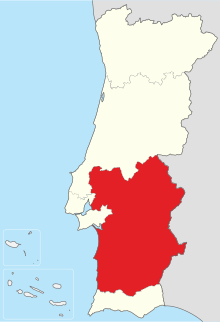
Alentejo (Vinho do Alentejo, Alentejo wines) is a Portuguese wine region from the Alentejo region. The entire region is entitled to use the Vinho Regional designation Alentejano VR, while some areas are also classified at the higher Denominação de Origem Controlada (DOC) level under the designation Alentejo DOC.[1][2] VR is similar to the French vin de pays and DOC to the French AOC. In the southern half of Portugal, the Alentejo region covers about a third of the country and is sparsely populated. In 2005, South Oregon University scientist Gregory V. Jones identified Alentejo ("southern Portugal" in his words) as the world's most challenged wine region (out of 27 world wine regions) from a climate change perspective. The region is noted for it vast cork production but has in recent years garnered attention for its table wine production.[3] Some producers of this region still make wine in great pottery vessels, as in Roman times.[4]
YouTube Encyclopedic
-
1/3Views:4641 2343 999
-
Reductive Winemaking vs. Traditional Winemaking! Differences and what consumers prefer???
-
Efficient Water Use Management in the Alentejo Region, Portugal
-
Why make wine in an amphora? Frank Cornelissen answers
Transcription
Subregions

There are eight subregions of the Alentejo region that are entitled to the Alentejo DOC designation. The names of the subregions may be indicated on the label together with the name Alentejo, for example as Alentejo-Borba. These subregions were initially created as separate Indicação de Proveniencia Regulamentada (IPR) wine regions, after which some were elevated to DOC status. In 2003, these separate DOCs and IPRs were put together as the Alentejo DOC.[5] Listed from north to south the eight subregions are the following.[3]
- Portalegre (formerly a DOC)
- Borba (formerly a DOC)
- Redondo (formerly a DOC)
- Evora (formerly an IPR)
- Reguengos (formerly a DOC)
- Granja-Amareleja (formerly an IPR)
- Vidigueira (formerly a DOC)
- Moura (formerly an IPR)
Grapes
The principal grapes of the Alentejo region includes Abundante, Alfrocheiro Preto, Alicante Bouschet, Antão Vaz, Arinto, Cabernet Sauvignon, Carignan, Chardonnay, Diagalves, Fernão Pires, Grand noir, Manteudo, Moreto, Palomino, Periquita, Rabo de Ovelha, Tempranillo, and Trincadeira.[3]
See also
References
- ^ ViniPortugal: Wine Regions Archived 2017-05-04 at the Wayback Machine, accessed on January 24, 2010
- ^ Jancis Robinson, ed. (2006). "Alentejo". Oxford Companion to Wine (Third ed.). Oxford: Oxford University Press. p. 11. ISBN 0-19-860990-6.
- ^ a b c T. Stevenson "The Sotheby's Wine Encyclopedia" pg 329-333 Dorling Kindersley 2005 ISBN 0-7566-1324-8
- ^ SILVA, A. J. M. (2014), (19) “Les vins au goût d’argile : anatomie d’une tradition plurimillénaire. Le cas d’étude portugais du vin de talha”, 138e Congrès des Sociétés Historiques et Scientifiques : Se nourrir, pratiques et stratégies alimentaires (Rennes, 22–26 April 2013), Éditions SHS, Rennes. https://www.academia.edu/10205544/Les_boissons_Les_vins_au_go%C3%BBt_d_argile_anatomie_d_une_tradition_plurimill%C3%A9naire._Le_cas_d_%C3%A9tude_portugais_du_vin_de_talha_.
- ^ Official Journal of the European Union C 187/1, 8.8.2009: List of quality wines produced in specified regions (reflects situation as of July 31, 2009)
